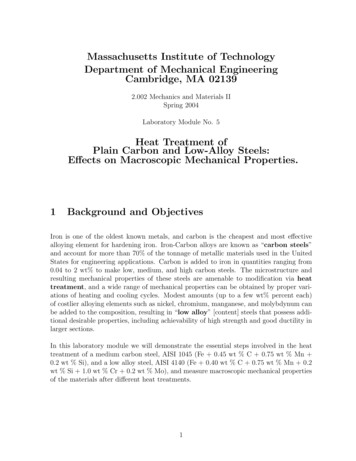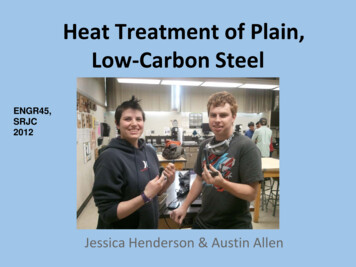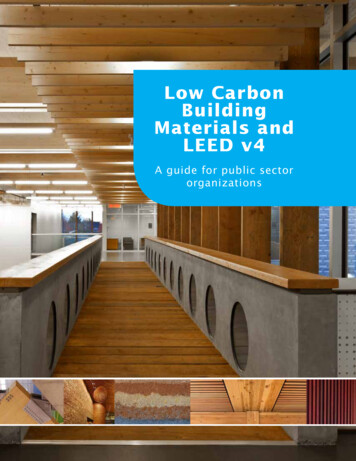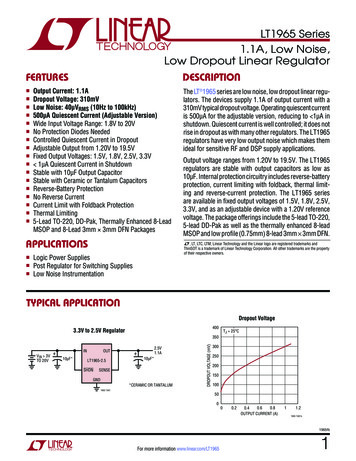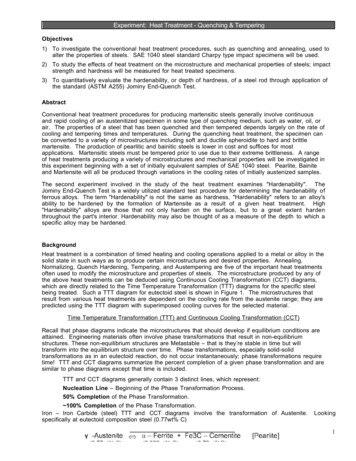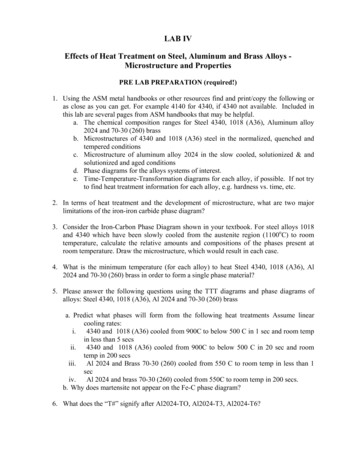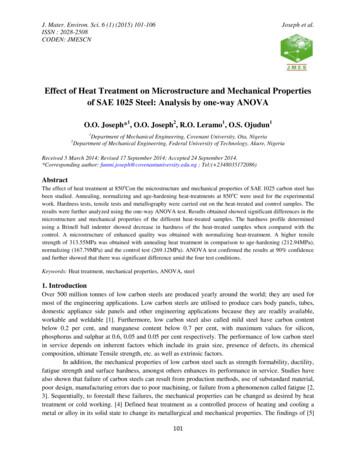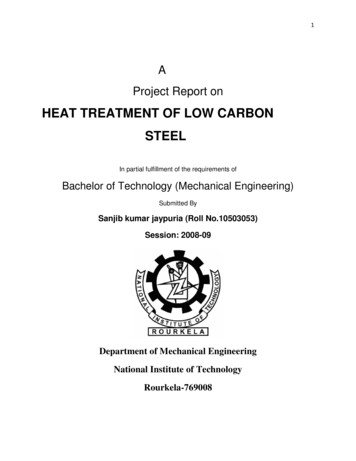
Transcription
1AProject Report onHEAT TREATMENT OF LOW CARBONSTEELIn partial fulfillment of the requirements ofBachelor of Technology (Mechanical Engineering)Submitted BySanjib kumar jaypuria (Roll No.10503053)Session: 2008-09Department of Mechanical EngineeringNational Institute of TechnologyRourkela-769008
2AProject Report onHEAT TREATMENT OF LOW CARBONSTEELIn partial fulfillment of the requirements ofBachelor of Technology (Mechanical Engineering)Submitted BySanjib kumar jaypuria (Roll No.10503053)Session: 2008-09Under the guidance ofProf. (Dr.) S. K. PatelDepartment of Mechanical EngineeringNational Institute of TechnologyRourkela-769008
3National Institute of TechnologyRourkelaCERTIFICATEThis is to certify that that the work in this thesis report entitled “Heat treatment oflow carbon steel” submitted by Sanjib kumar jaypuria in partial fulfillment of therequirements for the degree of Bachelor of Technology in Mechanical EngineeringSession 2008-2009 in the department of Mechanical Engineering, NationalInstitute of Technology Rourkela, Rourkela is an authentic work carried out by himunder my supervision and guidance.Date:Prof. (Dr) S. K. PatelDepartment of Mechanical EngineeringNational Institute of TechnologyRourkela - 769008
4ACKNOWLEDGEMENTWe deem it a privilege to have been the student of Mechanical Engineeringstream in National Institute of Technology, ROURKELA. Our heartfelt thanks to Dr.S. K. Patel, my project guide who helped me to bring out this project in goodmanner with his precious suggestion and rich experience. We take thisopportunity to express our sincere thanks to our project guide for cooperation inaccomplishing this project a satisfactory conclusion.Sanjib kumar jaypuriaRoll no: 10503053Mechanical EngineeringNational Institute of TechnologyRourkela - 769008
5CONTENTSChapter 1INTRODUCTION .9Chapter 2LITERATURE REVIEW .112.1. CARBON STEEL .112.1.1. LOW CARBON STEEL .112.2. HEAT TREATMENT . .112.2.1. ANNEALING .122.2.2. NORMALISING .122.2.3. HARDENING . .132.2.4. AUSTEMPERING . .132.2.5. MARTEMPERING . .132.2.6. TEMPERING 132.3. SURFACE HARDENING .132.3.1. FLAME AND INDUCTION HARDENING 142.3.2. NITRIDING .142.3.3. CYANIDING 142.3.4. CARBONITRIDING 15
62.3.5. CARBURIZING . .152.4. TYPES OF CARBURIZING PROCESS 162.4.1. GAS CARBURIZING .162.4.2. LIQUID CARBURIZING .172.4.3. PACK CARBURIZING 182.5. APPLICATION .20Chapter 3Literature Survey 22Chapter 4EXPERIMENTAL PROCEDURE . 244.1. SPECIMEN PREPARATION . 244.2. HEAT TREATMENT .244.2.1. ANNEALING . 244.2.2. NORMALIZING . . .254.2.3. QUENCHING . .254.2.4. TEMPERING . .254.2.5. AUSTEMPERING . .264.3. STUDY OF MECHANICAL PROPERTIES . .274.3.1. HARDNESS TESTING .274.3.2. ULTIMATE TENSILE STRENGTH TESTING .28
7Chapter 55.1. Results and Discussion .295.1.1. TABULATION FOR HARDNESS TESTING .295.1.2. TABULATION FOR ULTIMATE TENSILE ST .315.2. GRAPHS 345.3. DISCUSSION 345.4. CONCLUSION .38Chapter 6REFERENCES .39
8ABSTRACTLow carbon steel is easily available and cheap having all material properties thatare acceptable for many applications. Heat treatment on low carbon steel is toimprove ductility, to improve toughness, strength, hardness and tensile strengthand to relive internal stress developed in the material. Here basically theexperiment of harness and ultimate tensile strength is done to get idea aboutheat treated low carbon steel, which has extensive uses in all industrial andscientific fields.
9Chapter 1INTRODUCTION:As we know there is a little bit of steel in everybody life. Steel has many practicalapplications in every aspects of life. Steel with favorable properties are the bestamong the goods. The steel is being divided as low carbon steel, high carbon steel,medium carbon steel, high carbon steel on the basis of carbon content.Low carbon steel has carbon content of 0.15% to 0.45%. Low carbon steel is themost common form of steel as it’s provides material properties that are acceptablefor many applications. It is neither externally brittle nor ductile due to its lowercarbon content. It has lower tensile strength and malleable. Steel with low carbonsteel has properties similar to iron. As the carbon content increases, the metalbecomes harder and stronger but less ductile and more difficult to weld.The process heat treatment is carried out first by heating the metal and then coolingit in water, oil and brine water. The purpose of heat treatment is to soften the metal,to change the grain size, to modify the structure of the material and relive the stressset up in the material. The various heat treatment process are annealing,normalizing, hardening, austempering, mar tempering, tempering and surfacehardening.Case hardening is the process of hardening the surface of metal, often low carbonsteel by infusing elements into the metal surface forming a hard, wear resistanceskin but preserving a tough and ductile applied to gears, ball bearings, railwaywheels.As my project concerned it is basically concentrate on carburizing which is a casehardening process. It is a process of adding carbon to surface. These are done byexposing the part to carbon rich atmosphere at the elevated temperature (nearmelting point) and allow diffusion to transfer the carbon atoms into the steel. Thisdiffusion work on the principle of differential concentration.
10But it is not easy to go through all the carburizing process like gas carburizing,vacuum carburizing, plasma carburizing and salt bath carburizing.So we go through pack carburizing which can easily done in experimental setup. Inthis process the part that is to be carburized is placed in a steel container, so that itis completely surrounded by granules of charcoal which is activated by bariumcarbonate. The carburizing process does not harden the steel it only increases thecarbon content to some pre determined depth below the surface to a sufficient levelto allow subsequent quench hardening.The most important heat treatments and their purposes are:Stress relieving - a low-temperature treatment, to reduce or relieve Internal stressesremaining after castingAnnealing - to improve ductility and toughness, to reduce hardness and to removecarbidesNormalizing - to improve strength with some ductility Hardening and tempering to increase hardness or to give improved Strength and higher proof stress ratio.Austempering - to yield bainitic structures of high strength, with significantductility and good wear resistance.Surface hardening - by induction, flame, or laser to produce a local wear resistanthard surface.
11Chapter 22. Literature Review:2.1. Carbon steel:Carbon steel (plain carbon steel) is steel which contain main alloying element iscarbon. Here we find maximum up to 1.5% carbon and other alloying elements likecopper, manganese, silicon. Most of the steel produced now-a-days is plain carbonsteel. It is divided into the following types depending upon the carbon content.1.2.3.4.Dead or mild steel (up to 0.15% carbon)Low carbon steel (0.15%-0.45% carbon)Medium carbon steel(0.45%-0.8% carbon)High carbon steel (0.8%-1.5% carbon)Steel with low carbon content has properties similar to iron. As the carboncontent increases the metal becomes harder and stronger but less ductile andmore difficult to weld. Higher carbon content lowers the melting point and itstemperature resistance carbon content cannot alter yield strength of material.2.1.1. LOW CARBON STEEL:Low carbon steel has carbon content of 1.5% to 4.5%. Low carbon steel is themost common type of steel as its price is relatively low while its provides materialproperties that are acceptable for many applications. It is neither externally brittlenor ductile due to its low carbon content. It has lower tensile strength andmalleable.2.2. HEAT TREATMENT:The process of heat treatment is carried out first by heating the material andthen cooling it in the brine, water and oil. The purpose of heat treatment is tosoften the metal, to change the grain size, to modify the structure of the materialand to relieve the stress set up in the material after hot and cold working.
12The various heat treatment processes commonly employed in engineeringpractice as follows:-2.2.1. ANNEALING:Spherodizing:Spherodite forms when carbon steel is heated to approximately 700 forover 30 hours. The purpose is to soften higher carbon steel and allowmore formability. This is the softest and most ductile form of steel. Herecementite is present.Full annealing:Carbon steel is heated to approximately above the upper criticaltemperature (550-650) for 1 hour. Here all the ferrite transforms intoaustenite. The steel must then cooled in the realm of 38 per hour. Thisresults in a coarse pearlite structure. Full annealed steel is soft and ductilewith no internal stress.Process annealing:The steel is heated to a temperature below or close to the lower criticaltemperature (550-650), held at this temperature for some time and thencooled slowly. The purpose is to relive stress in a cold worked carbonsteel with less than 0.3%wt c.Diffusion annealing:The process consists of heating the steel to high temperature (11001200). It is held at this temperature for 3 hours to 20 hours and thencooled to 800-850 inside the furnace for a period of about 6 to 8 hours. Itis further cooled in the air to room temperature. This process is mainlyused for ingots and large casting. It is also called isothermal annealing.2.2.2.NORMALISING:The process of normalizing consist of heating the metal to a temperature of 30to 50 c above the upper critical temperature for hypo-eutectoid steels and by the
13same temperature above the lower critical temperature for hyper-eutectoid steel.It is held at this temperature for a considerable time and then quenched insuitable cooling medium. The purpose of normalizing is to refine grainstructure, improve machinibility and improve tensile strength, to remove strainand to remove dislocation.2.2.3.HARDENING:The process of hardening consist of heating the metal to a temperature of 30-50c above the upper critical point for hypo-eutectoid steels and by the sametemperature above the lower critical temperature for hyper-eutectoid steels. Itis held this temperature for some time and then quenched. The purposes ofhardening are to increase the hardness of the metal and to make suitable cuttingtools.2.2.4.AUSTEMPERING:It is a hardening process. it is also known as isothermal quenching. In thisprocess, the steel is heated above the upper critical temperature at about 875 cwhere the structure consists entirely of austenite. It is then suddenly cooled byquenching it in a salt bath maintained at a temperature of about 250 c to 525 c.2.2.5.MARTEMPERING:This process is also known as steeped quenching or interrupted quenching. Itconsists of heating steel above the upper critical temperature and quenching itin a salt bath kept at a suitable temperature.2.2.6.TEMPERING:This process consists of reheating the hardened steel to some temperature belowthe lower critical temperature, followed by any desired rate of cooling. Thepurpose is to relive internal stress, to reduce brittleness and to make steel toughto resist shock and fatigue.2.3. SURFACE HARDENING:In many engineering applications, it is desirable that steel being used shouldhave a hardened surface to resist wear and tear. At this time, it should have soft
14and tough interior or core so that it can absorb any shocks. Case hardening isthe process of hardening the surface of metal, often a low carbon steel byinfusing elements into the metal surface forming a hard, wear resistance skinbut preserving a tough and ductile interior. This type of treatment is applied togears, ball bearings, railway wheels. The various case hardening processes areas bonitridingFlame/induction hardening2.3.1. FLAME AND INDUCTION HARDENING:Flame or induction hardening are process in which the surfaces of the steel isheated to a high temperature (by direct application of flame or by inductionheating), then cooled rapidly using water this creates a case of martensite on thesurfaces. A carbon content of 0.4%-0.6%wt c is needed for this type of hardening.Typically uses are shackles of a lock, where the outer layer is hardened to befile resistant and mechanical gears, where hard gear mesh surface are needed tomaintain a long service life.2.3.2. NITRIDING:This process heats the steel part to 482-621 c in an atmosphere of ammonia gas anddissociated ammonia. The hardness is achieved by formation of nitrides. Theadvantage of this process is it causes little distortion.2.3.4. CYANIDING:The part is heated to 1600 -1750 c in a bath of sodium cyanide and then quenchedand rinsed in water and oil to remove any residual cyanide. This process producesa thin, hard shell (between 0.010 and 0.030 inches) that is harder than the oneproduced by carburizing and can be completed in 20 to 30 minutes. It is typicallyused on small parts such as bolts, nuts, screw and small gears. The majordisadvantage of cyaniding is that cyanide salts are poisonous.
152.3.5. CARBONITRIDING:Carbonitriding is a case hardening process in which steel is heated in a gaseousatmosphere of such composition that carbon and nitrogen are absorbedsimultaneously. The term carbonitriding is misleading because it implies amodified nitriding process. Actually carbonitriding is a modification ofcarburizing, and the name “nitro carburizing” would be more
Project Report on HEAT TREATMENT OF LOW CARBON STEEL In partial fulfillment of the requirements of Bachelor of Technology (Mechanical Engineering) Submitted By Sanjib kumar jaypuria (Roll No.10503053) Session: 2008-09 Department of Mechanical Engineering National Institute of Technology Rourkela-769008 . 2 A Project Report on HEAT TREATMENT OF LOW CARBON STEEL
